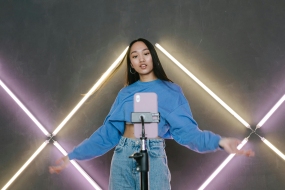In today's rapidly evolving digital landscape, influencer marketing has become a cornerstone for brands aiming to boost visibility, engage their audience, and drive conversions.
As we approach the end of 2024, this dynamic marketing strategy continues to gain momentum, with new trends and statistics highlighting its undeniable impact. Whether you're a small business or a global enterprise, leveraging the power of influencers can transform your marketing efforts. Let’s dive into the key statistics, trends, and real-world results from a recent CreatorLabz campaign to illustrate why influencer marketing should be part of your strategy in 2025.
Influencer Marketing by the Numbers: Industry Growth and Projections
The influencer marketing industry shows no signs of slowing down. According to recent projections, the market size is expected to reach $21 billion by the end of 2024. This growth is driven by the increasing shift of marketing budgets from traditional advertising channels to digital platforms, where influencers reign supreme.
- Growth Statistics:
- 80% of marketers consider influencer marketing effective and plan to increase their budget for it in 2025.
- 90% of brands say they get higher engagement and better customer trust through influencer-led campaigns.
- $5.78 ROI for every $1 spent: Influencer marketing continues to outperform traditional advertising, delivering significant returns on investment.
These numbers underscore a key trend: brands are finding more value in influencer marketing than ever before, not just in terms of visibility but also in driving actionable consumer behavior.
Breaking Down the ROI: Influencer Marketing vs. Traditional Advertising
One of the main reasons brands are flocking to influencer marketing is the impressive ROI it offers. Traditional advertising methods like TV, print, and even digital ads often struggle to capture consumer attention due to ad fatigue and the increasing use of ad blockers. In contrast, influencer marketing leverages authentic voices that resonate with audiences, leading to higher engagement and conversion rates.
- Higher Engagement: Influencer marketing campaigns achieve up to 8x higher engagement rates compared to standard digital advertising.
- Conversion Rates: Brands report an average 11x higher conversion rate when leveraging influencers, especially on platforms like Instagram, TikTok, and YouTube.
- Cost Efficiency: Influencer partnerships often prove more cost-effective than traditional ads, as they not only drive awareness but also encourage trust and loyalty.
Understanding Influencer Tiers: Nano, Micro, Macro, and Mega Influencers
Not all influencers are created equal. The effectiveness of an influencer campaign largely depends on choosing the right type of influencer based on your brand goals, target audience, and budget. Let's break down the different influencer tiers and their typical engagement rates:
| Influencer Type | Followers | Engagement Rate | Best For |
|---|---|---|---|
| Nano Influencers | 1K - 10K | 5-7% | Niche targeting, high authenticity |
| Micro Influencers | 10K - 100K | 3-5% | Brand awareness, higher engagement |
| Macro Influencers | 100K - 1M | 1.5-3% | Reaching broader audiences |
| Mega Influencers | 1M+ | 0.8-1.5% | Mass exposure, brand recognition |
Key Takeaways:
- Nano and Micro Influencers: These smaller-scale influencers are known for their highly engaged communities and authentic connections with followers. They are perfect for brands looking to build deeper connections, especially in niche markets.
- Macro and Mega Influencers: While their engagement rates are lower, they offer unparalleled reach, making them ideal for large-scale brand awareness campaigns.
2025 Trends in Influencer Marketing
The influencer marketing landscape is continuously evolving. Here are some of the top trends to watch in 2025:
- Rise of the Creator Economy:
- Influencers are moving beyond brand deals to create their own products, courses, and even entire brands. This shift emphasizes the power of long-term collaborations rather than one-off posts.
- Focus on Authenticity and Transparency:
- Audiences are increasingly savvy and skeptical of overly polished content. Brands that embrace authentic storytelling and transparency through influencers are seeing better engagement.
- Social Commerce and Live Shopping:
- Social media platforms are doubling down on social commerce features. Live shopping events hosted by influencers are driving impulse purchases and significantly increasing sales.
- Data-Driven Campaigns:
- Brands are leveraging AI-powered analytics to identify the most effective influencers, track real-time performance metrics, and optimize their campaigns for better ROI.
Case Study: How CreatorLabz Boosted Brand Awareness with Micro-Influencers
To demonstrate the power of influencer marketing, let's take a look at a recent campaign executed by CreatorLabz for a beauty brand aiming to increase brand awareness and drive online sales.
Campaign Overview:
- Objective: Increase brand visibility and drive traffic to the online store.
- Strategy: Partner with 20 micro-influencers in the beauty and skincare niche.
- Channels: Instagram Reels and TikTok.
- Duration: 4 weeks.
Results:
- Engagement Rate: Achieved an average of 6.5% engagement across all posts, significantly higher than the industry average of 3-5%.
- Reach: The campaign reached over 2 million targeted users, leading to a 25% increase in website traffic.
- Conversions: Generated a 15% boost in online sales, primarily driven by discount codes shared by influencers.
- ROI: For every $1 invested, the campaign delivered a $7.50 return in direct sales, demonstrating the power of micro-influencers in driving tangible results.
How to Leverage Influencer Marketing for Your Brand in 2025
If you're looking to harness the power of influencer marketing, here are a few actionable tips:
- Set Clear Goals: Define what you want to achieve—whether it’s brand awareness, lead generation, or driving sales.
- Choose the Right Influencers: Use data to identify influencers whose audience aligns with your target demographic.
- Focus on Authentic Content: Encourage influencers to create genuine, relatable content rather than overly promotional posts.
- Leverage Multiple Platforms: Don't limit your campaign to just one platform. Diversify across Instagram, TikTok, YouTube, and emerging channels for maximum reach.
- Measure and Optimize: Use analytics tools to track performance metrics like reach, engagement, and ROI. Continuously optimize your strategy based on these insights.
Conclusion
Influencer marketing is no longer just a trend; it's a critical component of a successful marketing strategy. With its proven ability to drive higher engagement, build brand trust, and deliver impressive ROI, it’s a channel that businesses cannot afford to ignore.
Ready to contact the right influencer marketing agency for your brand? Contact CreatorLabz today to explore how we can help you craft a data-driven influencer strategy that drives real results.







